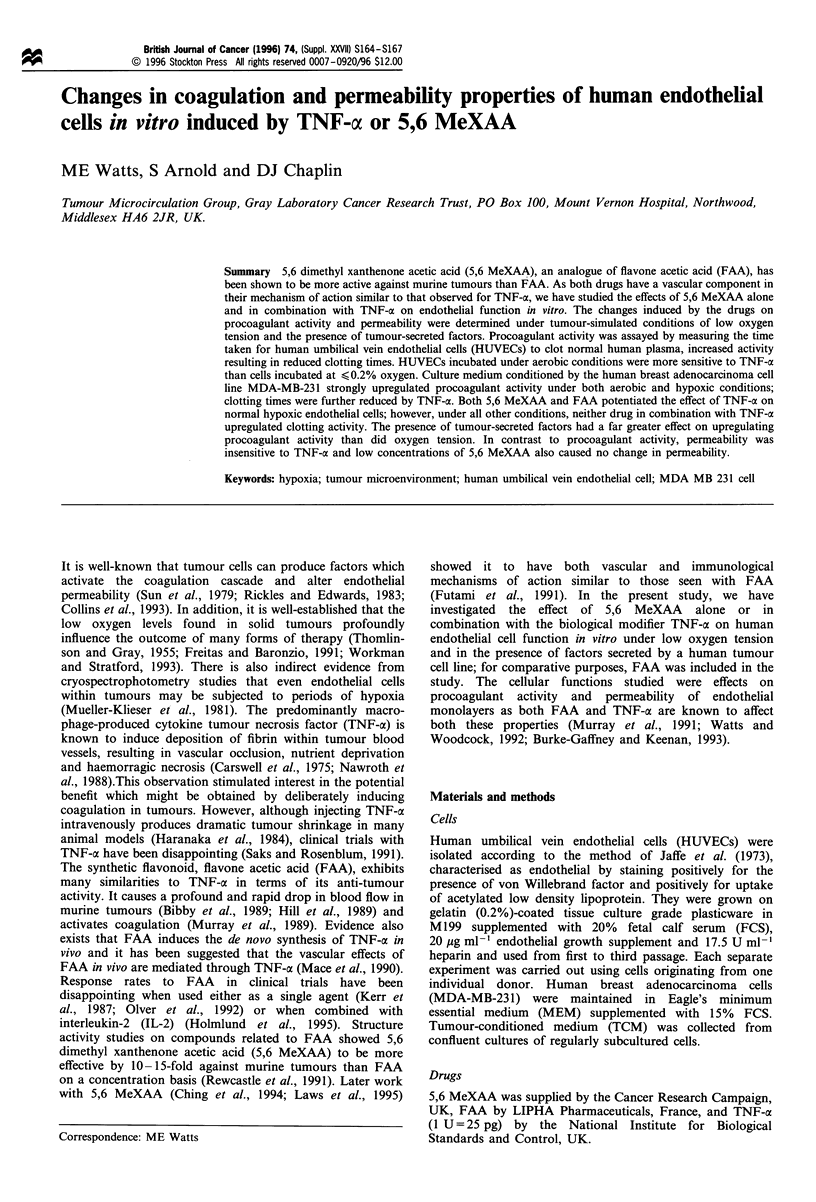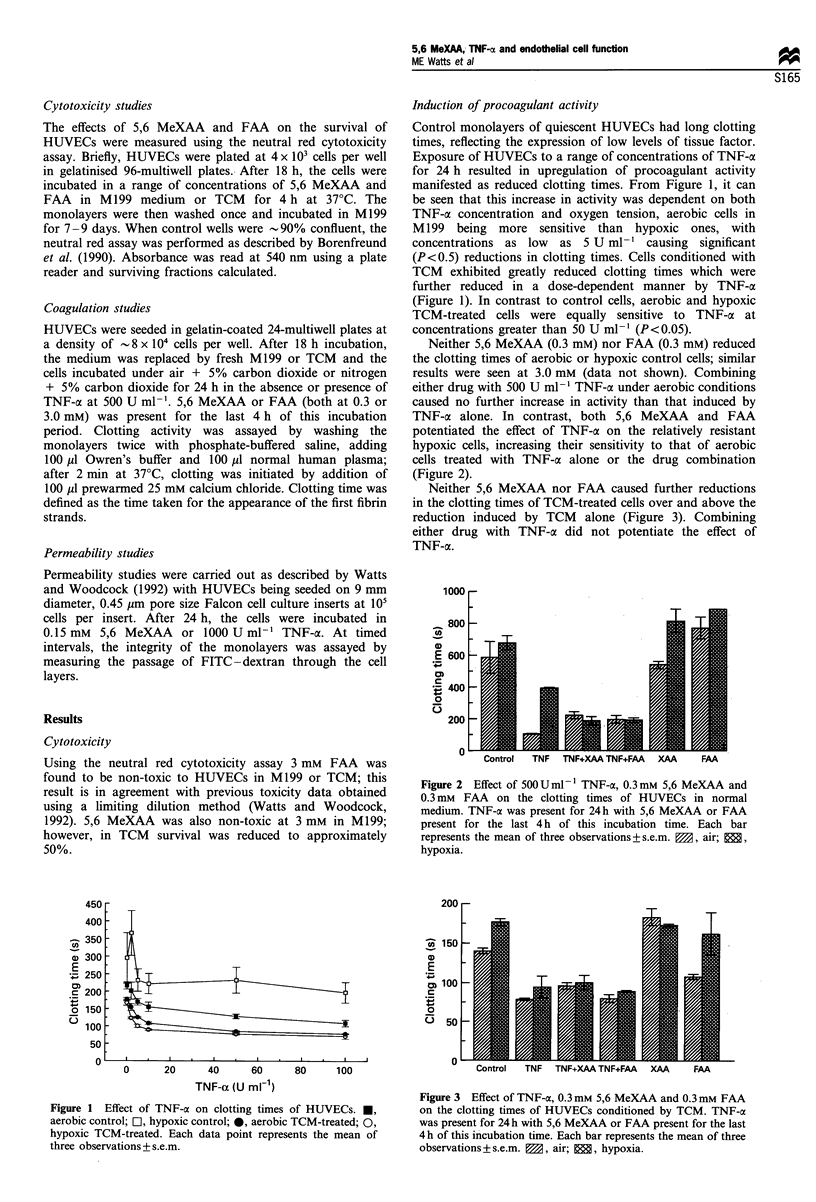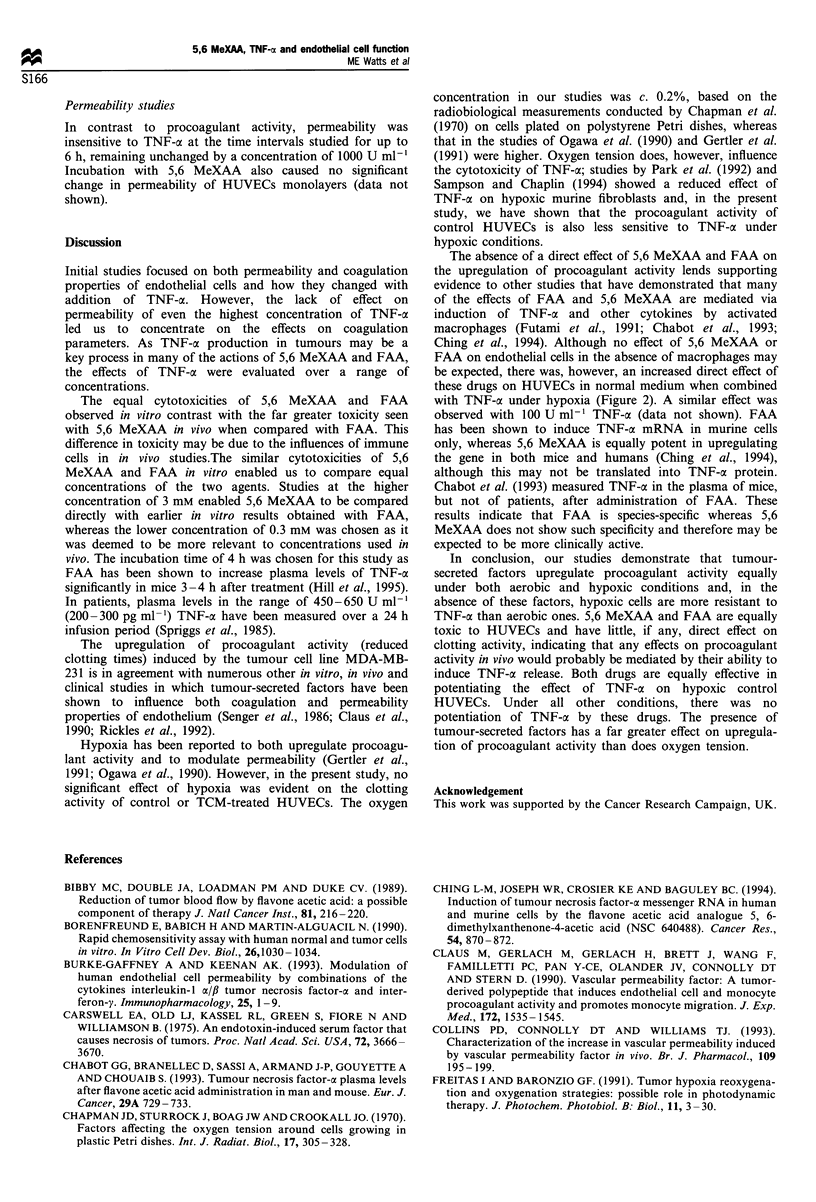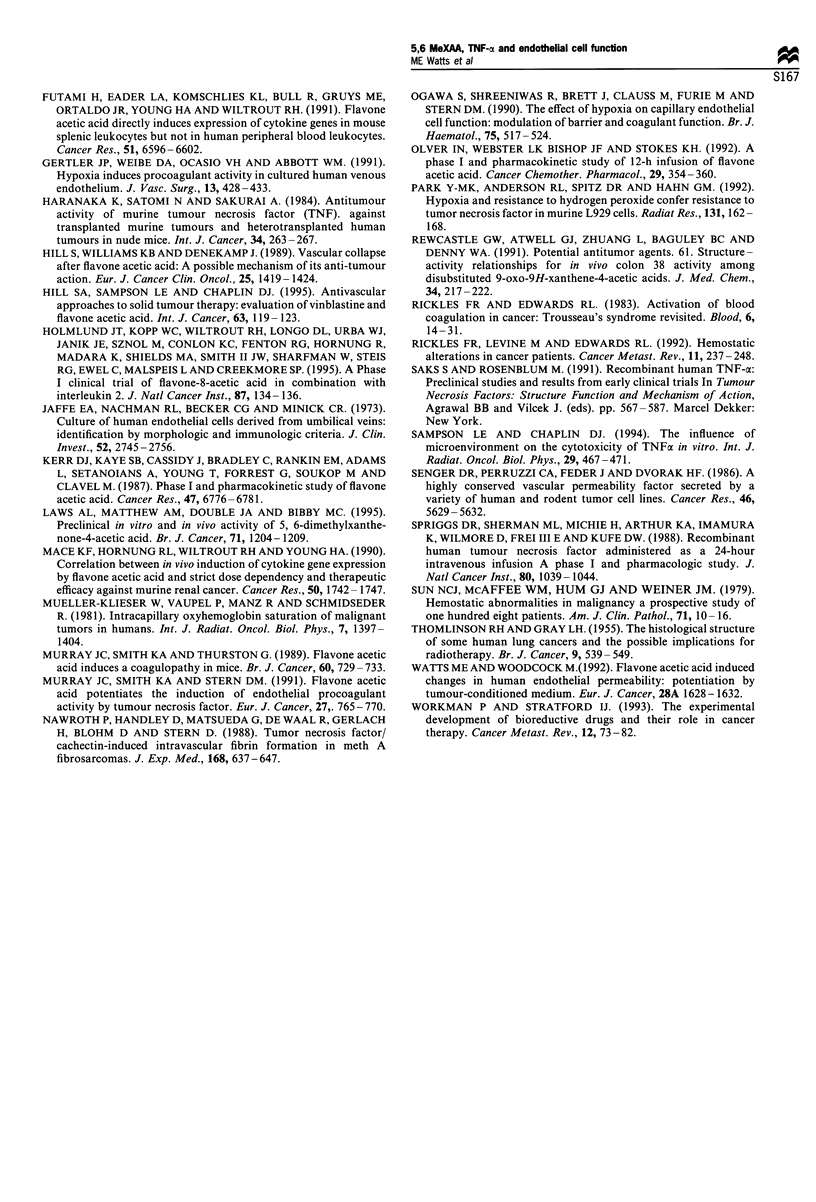Abstract
5,6 dimethyl xanthenone acetic acid (5,6 MeXAA), an analogue of flavone acetic acid (FAA), has been shown to be more active against murine tumours than FAA. As both drugs have a vascular component in their mechanism of action similar to that observed for TNF-alpha, we have studied the effects of 5,6 MeXAA alone and in combination with TNF-alpha on endothelial function in vitro. The changes induced by the drugs on procoagulant activity and permeability were determined under tumour-simulated conditions of low oxygen tension and the presence of tumour-secreted factors. Procoagulant activity was assayed by measuring the time taken for human umbilical vein endothelial cells (HUVECs) to clot normal human plasma, increased activity resulting in reduced clotting times. HUVECs incubated under aerobic conditions were more sensitive to TNF-alpha than cells incubated at < or = 0.2% oxygen. Culture medium conditioned by the human breast adenocarcinoma cell line MDA-MB-231 strongly upregulated procoagulant activity under both aerobic and hypoxic conditions; clotting times were further reduced by TNF-alpha. Both 5,6 MeXAA and FAA potentiated the effect of TNF-alpha on normal hypoxic endothelial cells; however, under all other conditions, neither drug in combination with TNF-alpha upregulated clotting activity. The presence of tumour-secreted factors had a far greater effect on upregulating procoagulant activity than did oxygen tension. In contrast to procoagulant activity, permeability was insensitive to TNF-alpha and low concentrations of 5,6 MeXAA also caused no change in permeability.
Full text
PDF



Selected References
These references are in PubMed. This may not be the complete list of references from this article.
- Bibby M. C., Double J. A., Loadman P. M., Duke C. V. Reduction of tumor blood flow by flavone acetic acid: a possible component of therapy. J Natl Cancer Inst. 1989 Feb 1;81(3):216–220. doi: 10.1093/jnci/81.3.216. [DOI] [PubMed] [Google Scholar]
- Borenfreund E., Babich H., Martin-Alguacil N. Rapid chemosensitivity assay with human normal and tumor cells in vitro. In Vitro Cell Dev Biol. 1990 Nov;26(11):1030–1034. doi: 10.1007/BF02624436. [DOI] [PubMed] [Google Scholar]
- Carswell E. A., Old L. J., Kassel R. L., Green S., Fiore N., Williamson B. An endotoxin-induced serum factor that causes necrosis of tumors. Proc Natl Acad Sci U S A. 1975 Sep;72(9):3666–3670. doi: 10.1073/pnas.72.9.3666. [DOI] [PMC free article] [PubMed] [Google Scholar]
- Chabot G. G., Branellec D., Sassi A., Armand J. P., Gouyette A., Chouaib S. Tumour necrosis factor-alpha plasma levels after flavone acetic acid administration in man and mouse. Eur J Cancer. 1993;29A(5):729–733. doi: 10.1016/s0959-8049(05)80355-7. [DOI] [PubMed] [Google Scholar]
- Chapman J. D., Sturrock J., Boag J. W., Crookall J. O. Factors affecting the oxygen tension around cells growing in plastic Petri dishes. Int J Radiat Biol Relat Stud Phys Chem Med. 1970;17(4):305–328. doi: 10.1080/09553007014550381. [DOI] [PubMed] [Google Scholar]
- Ching L. M., Joseph W. R., Crosier K. E., Baguley B. C. Induction of tumor necrosis factor-alpha messenger RNA in human and murine cells by the flavone acetic acid analogue 5,6-dimethylxanthenone-4-acetic acid (NSC 640488). Cancer Res. 1994 Feb 15;54(4):870–872. [PubMed] [Google Scholar]
- Clauss M., Gerlach M., Gerlach H., Brett J., Wang F., Familletti P. C., Pan Y. C., Olander J. V., Connolly D. T., Stern D. Vascular permeability factor: a tumor-derived polypeptide that induces endothelial cell and monocyte procoagulant activity, and promotes monocyte migration. J Exp Med. 1990 Dec 1;172(6):1535–1545. doi: 10.1084/jem.172.6.1535. [DOI] [PMC free article] [PubMed] [Google Scholar]
- Collins P. D., Connolly D. T., Williams T. J. Characterization of the increase in vascular permeability induced by vascular permeability factor in vivo. Br J Pharmacol. 1993 May;109(1):195–199. doi: 10.1111/j.1476-5381.1993.tb13553.x. [DOI] [PMC free article] [PubMed] [Google Scholar]
- Freitas I., Baronzio G. F. Tumor hypoxia, reoxygenation and oxygenation strategies: possible role in photodynamic therapy. J Photochem Photobiol B. 1991 Oct;11(1):3–30. doi: 10.1016/1011-1344(91)80264-i. [DOI] [PubMed] [Google Scholar]
- Futami H., Eader L. A., Komschlies K. L., Bull R., Gruys M. E., Ortaldo J. R., Young H. A., Wiltrout R. H. Flavone acetic acid directly induces expression of cytokine genes in mouse splenic leukocytes but not in human peripheral blood leukocytes. Cancer Res. 1991 Dec 15;51(24):6596–6602. [PubMed] [Google Scholar]
- Gertler J. P., Weibe D. A., Ocasio V. H., Abbott W. M. Hypoxia induces procoagulant activity in cultured human venous endothelium. J Vasc Surg. 1991 Mar;13(3):428–433. doi: 10.1067/mva.1991.25767. [DOI] [PubMed] [Google Scholar]
- Haranaka K., Satomi N., Sakurai A. Antitumor activity of murine tumor necrosis factor (TNF) against transplanted murine tumors and heterotransplanted human tumors in nude mice. Int J Cancer. 1984 Aug 15;34(2):263–267. doi: 10.1002/ijc.2910340219. [DOI] [PubMed] [Google Scholar]
- Hill S. A., Sampson L. E., Chaplin D. J. Anti-vascular approaches to solid tumour therapy: evaluation of vinblastine and flavone acetic acid. Int J Cancer. 1995 Sep 27;63(1):119–123. doi: 10.1002/ijc.2910630121. [DOI] [PubMed] [Google Scholar]
- Hill S., Williams K. B., Denekamp J. Vascular collapse after flavone acetic acid: a possible mechanism of its anti-tumour action. Eur J Cancer Clin Oncol. 1989 Oct;25(10):1419–1424. doi: 10.1016/0277-5379(89)90099-0. [DOI] [PubMed] [Google Scholar]
- Holmund J. T., Kopp W. C., Wiltrout R. H., Longo D. L., Urba W. J., Janik J. E., Sznol M., Conlon K. C., Fenton R. G., Hornung R. A phase I clinical trial of flavone-8-acetic acid in combination with interleukin 2. J Natl Cancer Inst. 1995 Jan 18;87(2):134–136. doi: 10.1093/jnci/87.2.134. [DOI] [PubMed] [Google Scholar]
- Jaffe E. A., Nachman R. L., Becker C. G., Minick C. R. Culture of human endothelial cells derived from umbilical veins. Identification by morphologic and immunologic criteria. J Clin Invest. 1973 Nov;52(11):2745–2756. doi: 10.1172/JCI107470. [DOI] [PMC free article] [PubMed] [Google Scholar]
- Kerr D. J., Kaye S. B., Cassidy J., Bradley C., Rankin E. M., Adams L., Setanoians A., Young T., Forrest G., Soukop M. Phase I and pharmacokinetic study of flavone acetic acid. Cancer Res. 1987 Dec 15;47(24 Pt 1):6776–6781. [PubMed] [Google Scholar]
- Laws A. L., Matthew A. M., Double J. A., Bibby M. C. Preclinical in vitro and in vivo activity of 5,6-dimethylxanthenone-4-acetic acid. Br J Cancer. 1995 Jun;71(6):1204–1209. doi: 10.1038/bjc.1995.234. [DOI] [PMC free article] [PubMed] [Google Scholar]
- Mace K. F., Hornung R. L., Wiltrout R. H., Young H. A. Correlation between in vivo induction of cytokine gene expression by flavone acetic acid and strict dose dependency and therapeutic efficacy against murine renal cancer. Cancer Res. 1990 Mar 15;50(6):1742–1747. [PubMed] [Google Scholar]
- Mueller-Klieser W., Vaupel P., Manz R., Schmidseder R. Intracapillary oxyhemoglobin saturation of malignant tumors in humans. Int J Radiat Oncol Biol Phys. 1981 Oct;7(10):1397–1404. doi: 10.1016/0360-3016(81)90036-5. [DOI] [PubMed] [Google Scholar]
- Murray J. C., Smith K. A., Stern D. M. Flavone acetic acid potentiates the induction of endothelial procoagulant activity by tumour necrosis factor. Eur J Cancer. 1991;27(6):765–770. doi: 10.1016/0277-5379(91)90185-g. [DOI] [PubMed] [Google Scholar]
- Murray J. C., Smith K. A., Thurston G. Flavone acetic acid induces a coagulopathy in mice. Br J Cancer. 1989 Nov;60(5):729–733. doi: 10.1038/bjc.1989.348. [DOI] [PMC free article] [PubMed] [Google Scholar]
- Nawroth P., Handley D., Matsueda G., De Waal R., Gerlach H., Blohm D., Stern D. Tumor necrosis factor/cachectin-induced intravascular fibrin formation in meth A fibrosarcomas. J Exp Med. 1988 Aug 1;168(2):637–647. doi: 10.1084/jem.168.2.637. [DOI] [PMC free article] [PubMed] [Google Scholar]
- Ogawa S., Shreeniwas R., Brett J., Clauss M., Furie M., Stern D. M. The effect of hypoxia on capillary endothelial cell function: modulation of barrier and coagulant function. Br J Haematol. 1990 Aug;75(4):517–524. doi: 10.1111/j.1365-2141.1990.tb07792.x. [DOI] [PubMed] [Google Scholar]
- Olver I. N., Webster L. K., Bishop J. F., Stokes K. H. A phase I and pharmacokinetic study of 12-h infusion of flavone acetic acid. Cancer Chemother Pharmacol. 1992;29(5):354–360. doi: 10.1007/BF00686003. [DOI] [PubMed] [Google Scholar]
- Park Y. M., Anderson R. L., Spitz D. R., Hahn G. M. Hypoxia and resistance to hydrogen peroxide confer resistance to tumor necrosis factor in murine L929 cells. Radiat Res. 1992 Aug;131(2):162–168. [PubMed] [Google Scholar]
- Rewcastle G. W., Atwell G. J., Li Z. A., Baguley B. C., Denny W. A. Potential antitumor agents. 61. Structure-activity relationships for in vivo colon 38 activity among disubstituted 9-oxo-9H-xanthene-4-acetic acids. J Med Chem. 1991 Jan;34(1):217–222. doi: 10.1021/jm00105a034. [DOI] [PubMed] [Google Scholar]
- Rickles F. R., Edwards R. L. Activation of blood coagulation in cancer: Trousseau's syndrome revisited. Blood. 1983 Jul;62(1):14–31. [PubMed] [Google Scholar]
- Rickles F. R., Levine M., Edwards R. L. Hemostatic alterations in cancer patients. Cancer Metastasis Rev. 1992 Nov;11(3-4):237–248. doi: 10.1007/BF01307180. [DOI] [PubMed] [Google Scholar]
- Sampson L. E., Chaplin D. J. The influence of microenvironment on the cytotoxicity of TNF [symbol: see text] vitro. Int J Radiat Oncol Biol Phys. 1994 Jun 15;29(3):467–471. doi: 10.1016/0360-3016(94)90440-5. [DOI] [PubMed] [Google Scholar]
- Senger D. R., Perruzzi C. A., Feder J., Dvorak H. F. A highly conserved vascular permeability factor secreted by a variety of human and rodent tumor cell lines. Cancer Res. 1986 Nov;46(11):5629–5632. [PubMed] [Google Scholar]
- Spriggs D. R., Sherman M. L., Michie H., Arthur K. A., Imamura K., Wilmore D., Frei E., 3rd, Kufe D. W. Recombinant human tumor necrosis factor administered as a 24-hour intravenous infusion. A phase I and pharmacologic study. J Natl Cancer Inst. 1988 Sep 7;80(13):1039–1044. doi: 10.1093/jnci/80.13.1039. [DOI] [PubMed] [Google Scholar]
- Sun N. C., McAfee W. M., Hum G. J., Weiner J. M. Hemostatic abnormalities in malignancy, a prospective study of one hundred eight patients. Part I. Coagulation studies. Am J Clin Pathol. 1979 Jan;71(1):10–16. doi: 10.1093/ajcp/71.1.10. [DOI] [PubMed] [Google Scholar]
- THOMLINSON R. H., GRAY L. H. The histological structure of some human lung cancers and the possible implications for radiotherapy. Br J Cancer. 1955 Dec;9(4):539–549. doi: 10.1038/bjc.1955.55. [DOI] [PMC free article] [PubMed] [Google Scholar]
- Watts M. E., Woodcock M. Flavone acetic acid induced changes in human endothelial permeability: potentiation by tumour-conditioned medium. Eur J Cancer. 1992;28A(10):1628–1632. doi: 10.1016/0959-8049(92)90056-8. [DOI] [PubMed] [Google Scholar]
- Workman P., Stratford I. J. The experimental development of bioreductive drugs and their role in cancer therapy. Cancer Metastasis Rev. 1993 Jun;12(2):73–82. doi: 10.1007/BF00689802. [DOI] [PubMed] [Google Scholar]


